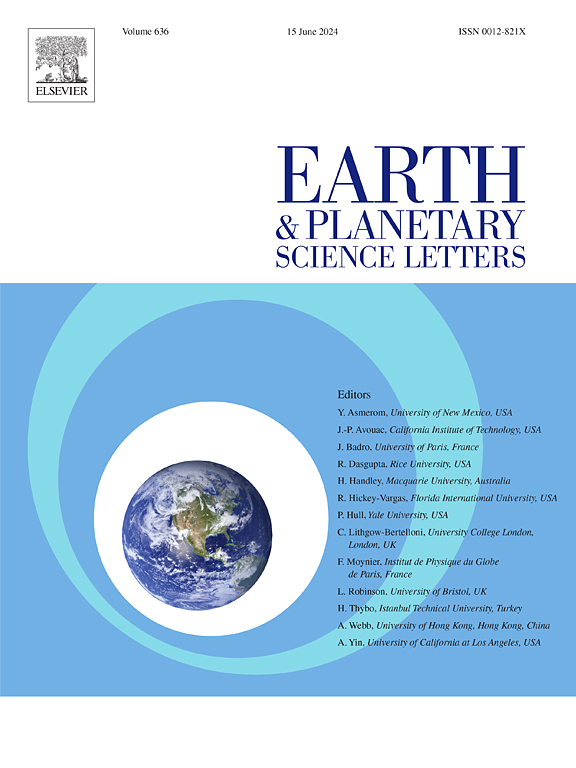Carboniferous, not Paleoproterozoic, eclogite-facies metamorphism in the northern North China Craton as revealed by in situ garnet Lu-Hf and U-Pb geochronology
IF 4.8
1区 地球科学
Q1 GEOCHEMISTRY & GEOPHYSICS
引用次数: 0
Abstract
Eclogites exposed within orogenic belts or cratonic margins provide critical records of oceanic subduction, continental collision, and supercontinent assembly. Understanding the timing and processes of Precambrian eclogite facies metamorphism is essential for elucidating the onset of modern-style plate tectonics on Earth. The eclogite in the northern margin of the North China Craton (NMNCC) has been regarded by some as key petrological evidence supporting the operation of modern-style plate tectonics during the Paleoproterozoic. However, there is significant controversy regarding the timing (Paleoproterozoic versus Carboniferous) of the peak eclogite-facies metamorphism in the NMNCC, primarily due to the presence of at least two generations of metamorphic zircons within the eclogites and their associated paragneisses. Here we conduct a comprehensive in situ Lu-Hf and U-Pb dating analysis of garnet, the principal mineral for recovering peak eclogite-facies P-T conditions, combined with zircon U-Pb isotopic and mineral inclusion analyses. This approach provides direct and precise geochronological constraints on the peak eclogite-facies metamorphism in the NMNCC. One paragneiss sample yields many Paleoproterozoic (ca. 1.85 Ga) zircon grains with metamorphic characteristics, while metamorphic zircons from other studied eclogite and paragneiss samples yield SIMS U-Pb ages ranging from 325.5 ± 2.0 Ma to 308.9 ± 3.4 Ma. In contrast, the garnets from all eclogite and paragneiss samples do not indicate Paleoproterozoic age and yield consistent in situ Lu-Hf ages of 354 ± 91 Ma to 369 ± 89 Ma and in situ U-Pb ages of 245 ± 180 Ma to 335 ± 27 Ma. The diffusivity of Lu, Hf, U, and Pb ions is substantially slower than that of major elemental cations (i.e., Ca2+, Mg2+, and Fe2+) in garnet. Therefore, the consistent Carboniferous garnet Lu-Hf and U-Pb ages cannot be ascribed to retrograde metamorphism or post-eclogite facies metamorphic overprint. Despite large analytical uncertainties, these ages provide definitive evidence that the eclogite facies metamorphism occurred during the Carboniferous, rather than the Paleoproterozoic. Considering the presence of garnet, rutile, and phengite inclusions within Carboniferous zircons, the obtained zircon U-Pb ages of 326–309 Ma are regarded as the best estimate for the timing of the eclogite facies metamorphism in the NMNCC. The Paleoproterozoic zircons in the paragneiss sample are likely of detrital origin, despite showing some metamorphic characteristics in CL images. The eclogite facies metamorphism likely recorded a collision event between the NMNCC and an island arc within the Paleo-Asian Ocean during the Carboniferous, rather than the onset of modern-style plate tectonics during the Paleoproterozoic. This study underscores the ability of in situ Lu-Hf and U-Pb dating of garnet in distinguishing various potential metamorphic episodes within individual samples and advocates for the reexamination of reported Precambrian eclogites worldwide using the in situ garnet U-Pb and Lu-Hf dating techniques, which are crucial for constraining the timing of the onset of modern-style plate tectonics.
求助全文
约1分钟内获得全文
求助全文
来源期刊

Earth and Planetary Science Letters
地学-地球化学与地球物理
CiteScore
10.30
自引率
5.70%
发文量
475
审稿时长
2.8 months
期刊介绍:
Earth and Planetary Science Letters (EPSL) is a leading journal for researchers across the entire Earth and planetary sciences community. It publishes concise, exciting, high-impact articles ("Letters") of broad interest. Its focus is on physical and chemical processes, the evolution and general properties of the Earth and planets - from their deep interiors to their atmospheres. EPSL also includes a Frontiers section, featuring invited high-profile synthesis articles by leading experts on timely topics to bring cutting-edge research to the wider community.
 求助内容:
求助内容: 应助结果提醒方式:
应助结果提醒方式:


